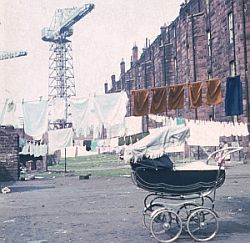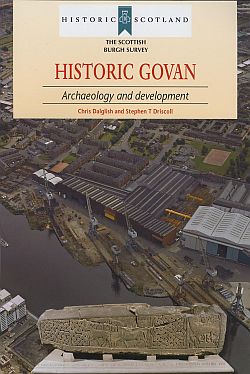Minister for Culture launches book on Govan's archaeology and development
Published: 19 February 2010
A new book, which reveals Govan's long and intriguing history, has been launched by the Minister for Culture Fiona Hyslop.
A new book, Historic Govan: Archaeology and Development, which reveals Govan's long and intriguing history, has been launched by the Minister for Culture Fiona Hyslop at the Pearce Institute in Govan. 
Written by Chris Dalglish and Stephen T Driscoll, Professor of Historical Archaeology at the University of Glasgow, the book is a guide to understanding Govan’s rich history and archaeology. It looks at the significance of Govan’s heritage including details of important sites, buildings and areas of potential. The book is the latest in the Scottish Burgh Surveys produced by Historic Scotland and the Council for British Archaeology and is the first book looking at the consolidation of Govan’s history and heritage since TCF Brotchie’s The History of Govan written a century ago in 1905.
Fiona Hyslop, Minister for Culture said: “Govan has a rich and fascinating history, from its beginnings as an early Christian centre to its celebrated role in ship-building on the Clyde. The burgh has one of the largest collections of early historic sculpture in Scotland, dating from the tenth century, located in Govan Old Parish Church, which stands upon one of the oldest Christian sites in Scotland.
“It also has an impressive and diverse Industrial heritage, including the magnificent former Fairfield Shipyard office building, for which Historic Scotland has provided grant assistance towards its conservation and conversion to new use. This project reflects the ongoing regeneration of the area, and how heritage can drive this forward. 
“Govan Cross has remained the focus of the community as a place of assembly and public activity despite the sweeping changes introduced by industrial and urban development. Modern Govan’s strong community identity must owe something to this deeply grounded sense of place.”
The Scottish Burgh series identifies the archaeological potential of Scotland’s historic towns to provide information to planning authorities when considering development proposals within these areas.
Professor Stephen T Driscoll said: “Few People realise that Govan is more ancient than Glasgow or that a thousand years before the titans of naval architecture colonised its shore it was the ceremonial centre of the Kings of Strathclyde.
“We hope that as a result of our efforts, the historical richness and cultural significance of Govan’s past will be more widely appreciated, but our main hope is that our survey will prove useful in the challenging work of remaking Govan.
“This is an important time for Govan and we hope that the accomplishments of past generations will serve as a source of confidence to the community and equally that the historical legacy will inspire those engaged in the regeneration process to produce a new Govan worthy of the old.”
The book is published by the Council for British Archaeology and can be obtained from their website: http://www.britarch.ac.uk/books/Govan2009
Further information:
Jennifer Johnston Watt, Media and Communications Officer
Historic Scotland
Tel: 0131 668 8070
Email: Jennifer.JohnstonWatt@scotland.gsi.gov.uk
Martin Shannon, Senior Media Relations Officer
University of Glasgow
Tel: 0141 330 8593
Email: m.shannon@admin.gla.ac.uk
First published: 19 February 2010
<< February

